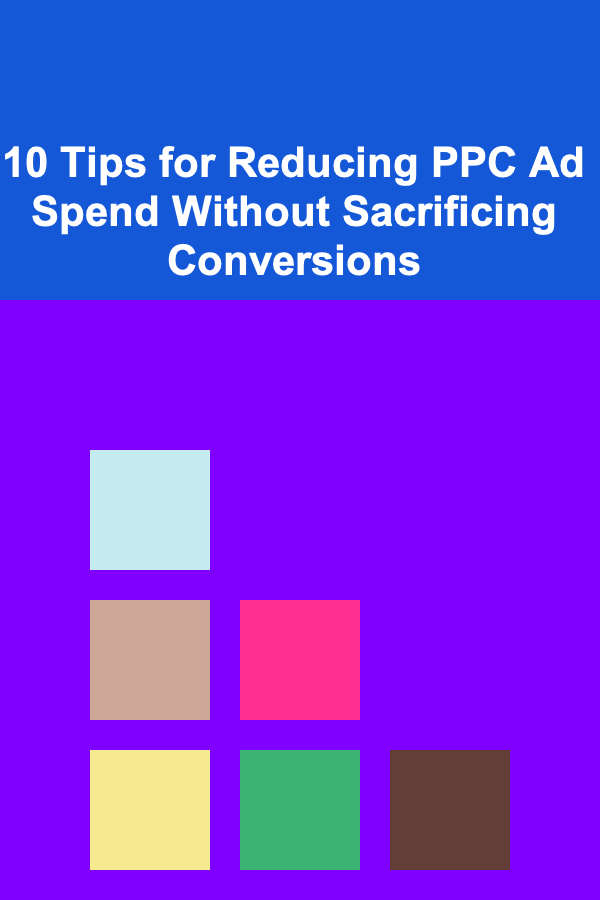
10 Tips for Reducing PPC Ad Spend Without Sacrificing Conversions
ebook include PDF & Audio bundle (Micro Guide)
$12.99$5.99
Limited Time Offer! Order within the next:

Pay-per-click (PPC) advertising has become an indispensable tool for businesses looking to gain visibility in competitive markets. It offers businesses an effective way to reach their target audience, drive traffic, and generate conversions. However, for many marketers and business owners, PPC campaigns can become expensive, especially when the return on investment (ROI) isn't meeting expectations.
While it is crucial to maintain a steady flow of conversions, it's equally important to keep costs in check. Striking the balance between reducing PPC ad spend and maintaining strong performance is essential to optimizing your marketing budget. In this article, we will explore 10 actionable tips that can help you reduce your PPC ad spend without compromising conversions.
Optimize Keyword Selection and Match Types
One of the most effective ways to reduce PPC costs is by refining your keyword strategy. When setting up PPC campaigns, it's easy to target broad, high-traffic keywords, but this approach often leads to overspending, as these keywords tend to be competitive and expensive.
Refine Your Keywords
Focusing on more specific, long-tail keywords is a great way to target a more niche audience at a lower cost. Long-tail keywords are less competitive but still highly relevant to your target market. Although they may have lower search volume, they often result in higher conversion rates due to their specific nature.
Adjust Match Types
Keyword match types also play a significant role in your ad spend. Broad match keywords can trigger ads for a wide variety of search terms, some of which may not be relevant to your business. Switching to more precise match types, such as phrase match or exact match, allows you to control which search queries trigger your ads, reducing wasted spend on irrelevant clicks.
Actionable Tips:
- Analyze keyword performance regularly and pause underperforming broad match keywords.
- Implement negative keywords to exclude irrelevant searches that drain your budget.
- Use exact match keywords for highly relevant terms with the potential to drive conversions.
Improve Quality Score
Google Ads uses a metric called Quality Score to determine how relevant your ad and landing page are to the search queries you're targeting. A higher Quality Score results in better ad positions and lower costs per click (CPC), allowing you to get more out of your budget.
Enhancing Ad Relevance
To improve Quality Score, focus on improving the relevance of your ads. Make sure that your ad copy is closely aligned with the keywords you're targeting. Using keyword-rich, compelling headlines and clear calls to action (CTAs) will improve ad relevance and performance.
Optimize Landing Pages
A highly relevant landing page that matches the ad's content is critical for boosting Quality Score. Ensure that your landing page delivers what the ad promises, provides a seamless user experience, and loads quickly. A well-optimized landing page will lower your bounce rate and increase your conversion rate, both of which can improve your Quality Score.
Actionable Tips:
- Regularly test and optimize your ad copy to increase relevance.
- Ensure your landing pages are relevant to the ads and provide a user-friendly experience.
- Use A/B testing to find the best combinations of keywords, ad copy, and landing page designs.
Utilize Ad Scheduling
Ad scheduling, also known as dayparting, is a feature in Google Ads that allows you to set specific times during the day when your ads are shown. By analyzing the performance of your ads at different times, you can identify high-converting hours and reduce ad spend during low-converting times.
Identify High-Converting Times
Look at your PPC campaign data to identify patterns in conversion rates across different hours and days of the week. For example, if you notice that your ads perform better during business hours, you can schedule your ads to show only during these peak hours.
Pause Ads During Off-Peak Hours
By pausing ads during non-peak hours, you can significantly cut down on unnecessary ad spend. For instance, if your product or service is more relevant to weekday professionals, showing ads during weekends or late evenings may lead to wasted spend without any meaningful returns.
Actionable Tips:
- Analyze the performance of your ads across different times and days of the week.
- Use ad scheduling to target only the hours or days that deliver the highest ROI.
- Pause ads during low-converting times to avoid wasting budget.
Leverage Ad Extensions
Ad extensions are additional pieces of information that expand your ads and make them more appealing to users. These include sitelink extensions, callout extensions, structured snippets, and more. Ad extensions can improve your click-through rate (CTR), which can lower your CPC.
Enhance User Experience
Extensions help provide more information to potential customers without requiring them to click on your ad. For example, sitelink extensions allow you to show additional pages of your website, such as product pages or contact information, which can improve engagement and conversions.
Increase CTR and Lower CPC
When used effectively, ad extensions can boost your CTR by making your ads more relevant and informative. A higher CTR signals to Google that your ad is relevant, which can help improve your Quality Score and reduce your CPC over time.
Actionable Tips:
- Set up relevant ad extensions such as sitelinks, callout, and location extensions.
- Ensure your ad extensions are directly relevant to the ad and landing page.
- Test different combinations of ad extensions to identify the most effective ones.
Optimize Device Targeting
With the increasing use of mobile devices, optimizing your PPC campaigns for specific devices is critical for reducing costs and improving conversion rates.
Targeting Specific Devices
By analyzing your campaign performance across different devices, you can identify which devices drive the best conversions. If your ads perform better on mobile devices than on desktops, you can allocate more of your budget to mobile devices and adjust your bid accordingly.
Adjust Bids for Mobile and Desktop
Adjusting bids based on device performance allows you to avoid overspending on devices that are not driving conversions. For example, if mobile users are more likely to convert, you can increase your bids for mobile devices to ensure your ads are shown more frequently to this audience.
Actionable Tips:
- Regularly monitor the performance of your ads across devices (mobile, desktop, tablet).
- Adjust bids based on device performance to allocate your budget more efficiently.
- Test mobile-optimized landing pages to ensure a seamless user experience.
Optimize for Local Targeting
If your business serves specific geographical areas, local targeting is a crucial strategy to reduce your PPC ad spend. Instead of targeting a broad audience, focusing on the most relevant geographic locations can improve both your ad relevance and conversion rates.
Focus on Location-Based Keywords
Using location-specific keywords (e.g., "best Italian restaurant in New York") can help you target users who are more likely to convert. By narrowing your focus to a specific geographic area, you can reduce competition and cost while reaching potential customers who are more likely to make a purchase.
Geo-Targeting and Location Extensions
Geo-targeting allows you to show ads only to users in specific geographic locations. Additionally, location extensions enable you to display your business address and phone number, making it easier for users in your area to find and contact you.
Actionable Tips:
- Use location-based keywords to target customers in your specific geographic area.
- Implement geo-targeting and location extensions to make it easier for local users to find your business.
- Adjust bids for specific locations based on performance and conversion rates.
Regularly Monitor and Refine Negative Keywords
Negative keywords are terms that prevent your ads from showing up for irrelevant searches. By identifying and adding negative keywords to your campaigns, you can eliminate clicks from users who are unlikely to convert, thus reducing wasteful ad spend.
Identify Irrelevant Keywords
Use tools like Google Ads' search term report to identify search terms that trigger your ads but do not result in conversions. For instance, if you sell high-end products, you may want to exclude terms like "cheap" or "discount."
Continuously Update Negative Keywords
Regularly review and update your list of negative keywords. This ensures that your ads do not appear for searches that could lead to wasted clicks and ad spend.
Actionable Tips:
- Regularly monitor search term reports to identify irrelevant keywords.
- Add negative keywords to your campaigns to prevent your ads from showing for irrelevant searches.
- Keep refining and updating your negative keyword list as new data comes in.
Test and Experiment with Ad Variations
A/B testing, also known as split testing, is a valuable method for optimizing your PPC campaigns and reducing ad spend. By experimenting with different variations of your ads, you can determine which ones perform best and allocate more budget to those high-performing ads.
Test Headlines, CTAs, and Landing Pages
A/B testing is a powerful way to identify which ad components resonate most with your audience. For instance, testing different headlines or calls to action (CTAs) can reveal which combinations drive more clicks and conversions.
Use Data to Inform Decisions
Make data-driven decisions based on your A/B test results. Once you have identified the most effective ad copy, focus your budget on these high-performing ads, and pause or adjust underperforming ads.
Actionable Tips:
- Regularly run A/B tests to determine which variations of ads and landing pages perform best.
- Focus your budget on the top-performing ads and adjust your bidding strategy accordingly.
- Analyze results from A/B tests to identify trends and patterns that can inform future ad designs.
Retarget with Precision
Retargeting allows you to re-engage visitors who have interacted with your website or ads but have not converted. This strategy ensures that you only target users who have already shown an interest in your product, improving your chances of conversion while reducing wasted spend.
Use Retargeting for High-Intent Audiences
Retarget your ads to visitors who have shown a high level of interest, such as users who have added products to their cart but didn't complete the purchase. By focusing on these high-intent users, you can improve your conversion rate while minimizing unnecessary ad spend.
Refine Your Retargeting Audiences
Make sure you're not showing the same ad to users who have already converted. Segment your audience based on their behavior, and create personalized ads for each group to increase the likelihood of conversion.
Actionable Tips:
- Use retargeting to re-engage users who have already visited your website or interacted with your ads.
- Refine your audience segments to target high-intent users more effectively.
- Personalize your retargeting ads based on user behavior to increase relevance and conversions.
Monitor and Adjust Your Bids
Constantly monitoring and adjusting your bids is essential to ensuring you don't overspend on PPC ads. By refining your bidding strategy, you can ensure that you're getting the most value for your ad spend while still reaching your target audience.
Bid Adjustments Based on Performance
Monitor the performance of your campaigns, and adjust your bids based on factors like device, location, and time of day. For example, if certain devices or locations are delivering better conversions, increase your bids for those segments to maximize ROI.
Automate Bidding Strategies
Consider using automated bidding strategies like Target CPA (Cost per Acquisition) or Target ROAS (Return on Ad Spend), which adjust bids in real-time based on your goals. These automated strategies can help you optimize your bids while reducing manual effort.
Actionable Tips:
- Regularly monitor bid performance and adjust your bids based on performance.
- Use automated bidding strategies to optimize your campaigns based on specific goals.
- Test different bidding strategies to determine which one delivers the best ROI.
Conclusion
Reducing your PPC ad spend without sacrificing conversions is possible with careful strategy, regular optimization, and a data-driven approach. By implementing these 10 tips---focusing on keyword refinement, improving Quality Score, using ad scheduling, optimizing devices, and leveraging retargeting---you can lower your costs while maximizing your campaign's efficiency.
Remember, reducing ad spend doesn't mean cutting corners; it means being smarter with your budget and using the tools at your disposal to get the most out of every dollar spent. With these strategies, you can create a more sustainable and cost-effective PPC campaign that continues to drive conversions and deliver results for your business.
Reading More From Our Other Websites
- [Home Security 101] How to Prevent Home Break-Ins: Effective Tips for Keeping Intruders Out
- [Home Budget 101] How to Save Money on Home Decor and Still Achieve a Stylish Look
- [Star Gazing Tip 101] A Beginner's Guide to Identifying Stars and Planets from Within the City
- [Weaving Tip 101] Weaving as Meditation: Finding Calm and Creativity One Stitch at a Time
- [Polymer Clay Modeling Tip 101] Eco-Friendly Alternatives and Tips for Reducing Waste When Working with Sculpey
- [Personal Financial Planning 101] How to Save for Your Child's College Fund
- [Home Lighting 101] How to Use Light to Make Your Home Feel More Inviting
- [Personal Investment 101] Earning Passive Income by Creating AI-Powered Websites
- [Soap Making Tip 101] Shea Butter Secrets: Boosting Moisture in Your Handmade Soap
- [Home Space Saving 101] How to Double Your Space: Utilizing Bookshelves as Room Dividers with Integrated Storage

How to Create a Complete Baby Essentials Checklist for New Parents
Read More
How To Master Face Mapping for Skin Concerns
Read More
Passive Income from Deep Learning: The Best Strategies
Read More
How to Ace Your Logistics Coordinator Interview
Read More
10 Apps and Websites for Solving Sudoku Puzzles
Read More
10 Tips for Mastering the Pilates Roll-Up
Read MoreOther Products

How to Create a Complete Baby Essentials Checklist for New Parents
Read More
How To Master Face Mapping for Skin Concerns
Read More
Passive Income from Deep Learning: The Best Strategies
Read More
How to Ace Your Logistics Coordinator Interview
Read More
10 Apps and Websites for Solving Sudoku Puzzles
Read More